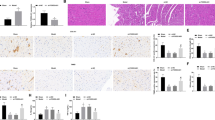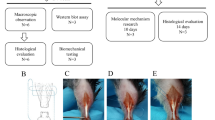Abstract
Background
Achilles tendons heal slower than other tissues, therefore requiring the developmnent of a strategy for accelerating the process. Vascular supply plays an important role in primary tendon healing, especially during the early healing phase. MicroRNA (miR)-210 has been reported as being crucial for angiogenesis, which is a key factor of tissue repair. We report herein that local injection of synthetic miR-210 into the injured Achilles tendon of a rat accelerated healing of the tendon.
Methods
Achilles tendons were transected and repaired via the Kessler suture technique in Sprague–Dawley rats. Then, double stranded (ds) miR-210 was injected into the repaired sites. The control group was injected with non-functioned dsRNA. At 2, 6 and 12 weeks, histological evaluations were performed. At two and six weeks, mechanical testing and angiogenesis were evaluated. Gene expression analysis using real-time polymerase chain reaction (PCR) and immunohistochemistry were performed at two weeks.
Result
At two and six weeks, regular dense collagen tissue in the miR-210 group was observed and the diameter of collagen fiber in the miR-210 group was significantly higher than in the control. At two weeks, the ultimate failure load was significantly higher than in the control group, and expression of VEGF, FGF2 and type I collagen was upregulated. Abundant vessels in the miR-210 group were observed at two weeks, but there was no significant difference in vessel numbers between the two groups at six weeks. At 12 weeks, repaired Achilles tendons in the miR-210 group consisted of parallel and dense fibers, whereas wavy and loose fibers were still observed in the control group.
Conclusion
The current study showed that single local injection of synthetic miR-210 promotes Achilles tendon healing in the early phase.







Similar content being viewed by others
References
Leppilahti J, Puranen J, Orava S. Incidence of Achilles tendon rupture. Acta Orthop Scand. 1996;67(3):277–9.
Inglis AE, Scott WN, Sculco TP, Patterson AH. Ruptures of the tendon Achilles: an objective assessment of surgical and non-surgical treatment. J Bone Jt Surg Am. 1976;58(7):990–3.
Persson A, Wredmark T. The treatment of total ruptures of the Achilles tendon by plaster immobilization. Int Orthop. 1979;3(2):149–52.
Wilkins R, Bisson LJ. Operative versus nonoperative management of acute Achilles tendon ruptures. Am J Sports Med. 2012;40(9):2154–60.
Nilsson-Helander KS, Silbernagel KG, Thomee R, Faven E, Olsson N, Eriksson BI, Karlsson J. Acute Achilles tendon rupture: a randomized, controlled study comparing surgical and nonsurgical treatments using validated outcome measures. Am Sports Med. 2010;38(11):2186–93.
Willits K, Amendola A, Bryant D, Mochtadi NG, Giffin JR, Fowler P, Kean CO, Kirkley A. Operative versus nonoperative treatment of acute Achilles tendon rupture: a multicenter randomized trial using accelerated functional rehabilitation. J Bone Jt Surg Am. 2010;92(17):2767–75.
Zhang F, Liu H, Stile F, Lei MP, Pang Y, Oswald TM, Beck J, Dovsestt-Martin W, Lineaweaver WC. Effect of vascular endothelial growth factor on rat Achilles tendon healing. Plast Reconstr Surg. 2003;112(6):1613–9.
Huang TF, Yew TL, Chiang ER, Ma HL, Hsu CY, Hsu SH, Hsu YT, Hung SC. Mesenchymal stem cells from a hypoxic culture improve and engraft achilles tendon repair. Am J Sports Med. 2013;41(5):1117–25.
Ambros V. The functions of animal microRNAs. Nature. 2004;431(7006):350–5.
Bartel DP, Chen CZ. MicroRNAs: genomics, biogenesis, mechanism, and function. Cell. 2004;116(2):281–97.
Lim LP, Lau NC, Garrett-Engele P, Grimson A, Scelter JM, Castle J, Bartel DP, Linsley PS, Johnson JM. Microarray analysis shows that some microRNAs downregulate large numbers of target mRNAs. Nature. 2005;433(7027):769–73.
Elmen J, Lindow M, Schutz S, Lawrence M, Petri A, Obad S, Lindholm M, Hedjarn M, Hanshen HF, Berger U, Gullans S, Kearney P, Sarnow P, Straarup EM, Kaupinnen S. LNA-mediated microRNA silencing in non-human primates. Nature. 2008;452(7189):896–9.
Krutzfeldt J, Rajewsky N, Braich R, Kallanthothil G, Rajeev KG, Tuschl T, Manoharan M. Silencing of microRNAs in vivo with ‘antagomirs’. Nature. 2005;438:685–9.
Nakasa T, Miyaki S, Okubo A, Hashimoto M, Nishida K, Ochi M, Asahara H. Expression of microRNA-146 in rheumatoid arthritis synovial tissue. Arthr Rheum. 2008;58(5):1284–92.
Yamasaki K, Nakasa T, Miyaki S, Ishikawa M, Deie M, Adachi N, Yasunaga Y, Asahara H, Ochi M. Expression of microRNA-146a in osteoarthritis cartilage. Arthr Rheum. 2009;60(4):1035–41.
Shoji T, Nakasa T, Yamasaki K, Kodama A, Miyaki S, Niimoto T, Okuhara A, Kamei N, Adachi N, Ochi M. The effect of intra-articular injection of microRNA-210 on ligament healing in a rat model. Am J Sports Med. 2012;40(11):2470–8.
Nakasa T, Ishikawa M, Shi M, Shibuya H, Adachi N, Ochi M. Acceleration of muscle regeneration by local injection of muscle specific microRNAs in rat skeletal muscle injury model. J Cell Mol Med. 2010;14(10):2495–505.
Fasanaro P, D’Alessandra Y, Di Stefano V, Malchionna R, Romani S, Pompilio G, Capogrossi MC, Martelli F. MicroRNA-210 modulates endothelial cell response to hypoxia and inhibits the receptor tyrosine kinase ligand ephrin-A3. J Biol Chem. 2008;283:15878–83.
Ivan M, Harris AL, Martelli F, Kulshreshtha R. Hypoxia response and microRNAs: no longer two separate worlds. J Cell Mol Med. 2008;12(5A):1426–31.
Fasanaro P, Greco S, Lorenzi M, Pescatori M, Brioschi M, Kulshereshtha R, Banfi C, Stubbs A, Calin GA, Ivan M, Capogrossi MC, Fabio. An integrated approach for experimental target identification of hypoxia-induced miR-210. J Biol Chem. 2009;284(50):35134–43.
Aspenberg P, Virchenko O. Platelet concentrate injection improves Achilles tendon repair in rats. Acta Orthop Scand. 2004;75(1):93–9.
Liu SH, Yang RS, al-Shaikh R, Lane JM. Collagen in tendon, ligament, and bone healing: a current review. Clin Orthop. 1995;318:265.
Gelberman RH, Khabie V, Cahill CJ. The revascularization of healing flexor tendons in the digital sheath: a vascular injection study in dogs. J Bone Jt Surg Am. 1991;73(6):868–81.
Sharma P, Maffulli N. Tendon injury and tendinopathy: healing and repair. J Bone Jt Surg Am. 2005;87(1):187–202.
Molloy T, Wang Y, Murrel G. The role of growth factors in tendon and ligament healing. Sports Med. 2003;33(5):381–94.
Kashiwagi K, Mochizuki Y, Yasunaga Y, Ishida O, Deie M, Ochi M. Effect of transforming growth factor-beta 1 on the early stages of healing of the Achilles tendon in a rat model. Scand J Plast Reconstr Surg Hand Surg. 2004;38(4):193–7.
Virchenko O, Fahlgren A, Skoglund B, Aspenberg P. CDMP-2 injection improves early tendon healing in a rabbit model for surgical repair. Scand J Med Sci Sports. 2005;15(4):260–4.
Hu S, Huang M, Li Z, Jin F, Ghosh Z, Lijkwan MA, Fasanaro P, Sun N, Wang X, Martelli F, Robbins RC, Wu JC. MicroRNA-210 as a novel therapy for treatment of ischemic heart disease. Circulation. 2010;122(11 suppl):2124–31.
Nakasa T, Shibuya H, Nagata Y, Niimoto T, Ochi M. The inhibitory effect of microRNA-146a expression on bone destruction in collage-induced arthritis. Arthr Rheum. 2011;63(6):1582–90.
Wilkins R, Bisson LJ. Operative versus nonoperative management of acute Achilles tendon ruptures. A quantitative systemic review of randomized controlled trials. Am J Sports Med. 2012;40(9):2154–60.
Acknowledgments
This research was supported by MEXT KAKENHI Grant-in-Aid for Scientific Research (A) Grant Number 21249079 (M.O.), Scientific Research (B) Grant number 25293324 (N.K.) and Scientific Research (C) Grant Number 24592234 (T.N.).
Conflict of interest
The authors declare that they have no conflict of interest.
Author information
Authors and Affiliations
Corresponding author
About this article
Cite this article
Usman, M.A., Nakasa, T., Shoji, T. et al. The effect of administration of double stranded MicroRNA-210 on acceleration of Achilles tendon healing in a rat model. J Orthop Sci 20, 538–546 (2015). https://doi.org/10.1007/s00776-015-0709-5
Received:
Accepted:
Published:
Issue Date:
DOI: https://doi.org/10.1007/s00776-015-0709-5




